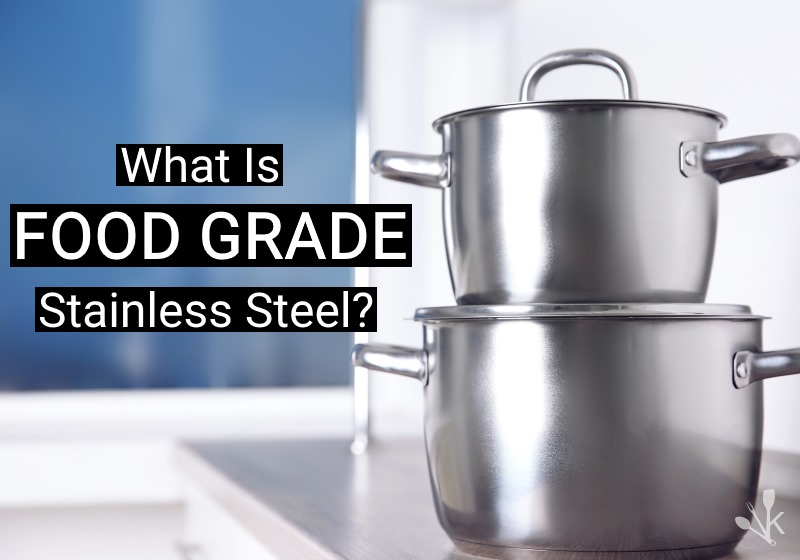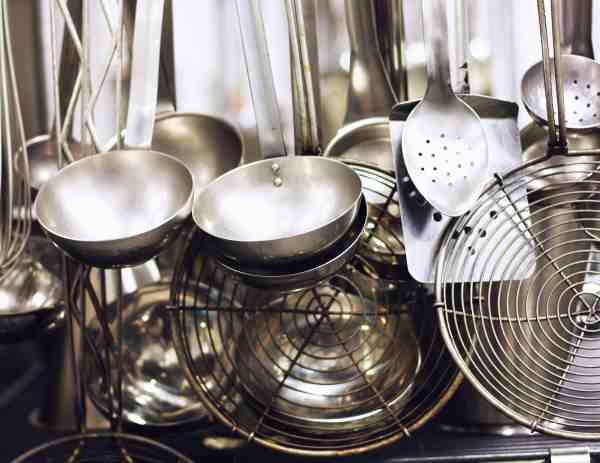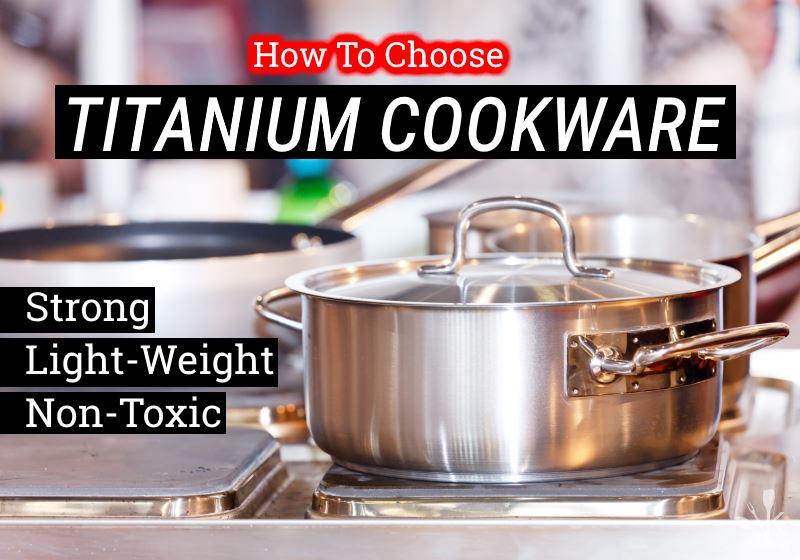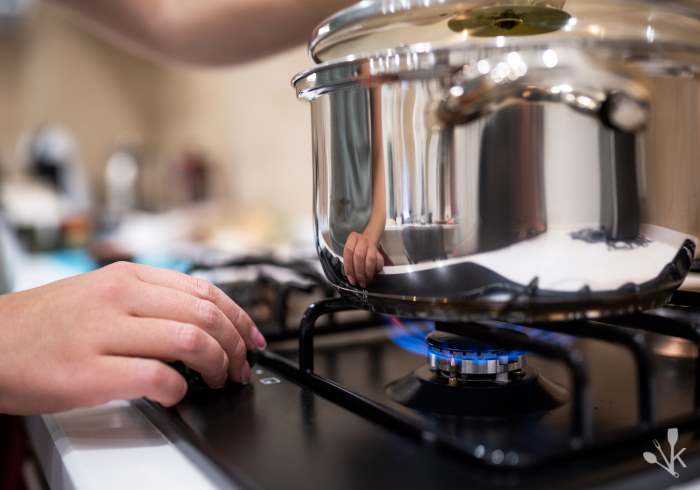Stainless steel cookware is a great option for basic pots and pans. This cookware is often built in layers or plys. While stainless is non-reactive, it doesn’t conduct heat extremely well, so it’s often layered with aluminum or copper.
Older stainless pans may be only 2-ply and display a copper bottom.

Stainless Steel Facts
What Is Stainless Steel Made Of?
Stainless steel is a combination of metals, also known as an alloy. When reviewing stainless steel for the kitchen, you’ll see numbers such as 18/10 or 18/8. These numbers refer to the amount of chromium/nickel included in the alloy.
Chromium bonds to the steel, preventing corrosion, and nickel toughens the steel, making it less likely to dent or bend.
Food Grade Stainless Steel
Stainless steel is a popular metal for manufacturing cooking utensils because it’s very stable and highly resistant to corrosion.

Additionally, stainless steel easily forms into the desired shape, and can be finished or polished to a decorative sheen.
Non-Reactive Vs. Reactive Metals
Acidic foods such as lemons and tomatoes can react badly with some pans, leaching out iron and copper. Foods high in alkalis, such as milk, can also be altered, even becoming inedible when exposed to some metals.
Food grade stainless steel is capable of cooking foods across the entire pH spectrum.
What Do The Numbers Mean?
The most common application for stainless steel in the kitchen is in cooking pots and stainless steel utensils.
If you’re planning on investing in new cookware or knives, a working knowledge of the properties of stainless steel is critical to make sure you get the best products for your needs.
Stainless Steel In The Kitchen – 300 Series
The 300 series of stainless steel, for cooking purposes, refers either to 304 or 316. Each stainless steel alloy has an ideal application.
Qualities Of 304
304 is the most common form of stainless used in the kitchen. If you see the numbers 18/8 or 18/10 (chromium/nickel), the piece you’re studying is made of 304 stainless steel. The more nickel present in the pot, the more durable it is, and the less likely it is to bend or dent.
There are people that are sensitive to nickel. If you suffer from a nickel allergy or nickel sensitivity, you may want to cook in ceramic coated cast iron cookware instead.
It’s also interesting to note that any leaching of nickel or chromium from your stainless steel cookware will be greatly reduced as the pots age.
Qualities Of 316
316 steel offers more corrosion resistance than 304. This steel is also referred to as surgical grade, though 420 is generally called surgical steel. It is used in cooking applications, but is not as common as 304.
This steel is often found in marine applications and is even used in nuclear power plants.
Stainless Steel In The Kitchen – 400 Series
416 and 420 series stainless steel are often referred to as “cutlery grade.” These alloys can be physically broken down in the sharpening process yet still retain their corrosion resistant properties.
When considering stainless steel vs surgical steel knives, your habits should come into consideration. We’ve all forgotten and run a good knife through the dishwasher, though most knife brands and manufacturers don’t recommend this treatment.
Surgical steel is much more corrosion resistant and can tolerate humidity more effectively.
Surgical Steel Vs Stainless Steel
Steel with a label of 420 is referred to as surgical steel. This steel contains molybdenum, which enhances its corrosion resistant properties.

An important note when comparing 300 series vs 400 series stainless steel: 400 series will hold a sharper edge for longer. However, this steel is more brittle.
Benefits And Limitations Of Stainless Steel In The Kitchen
Is Stainless Steel Rust Proof?
No, stainless steel can rust. It is, however, corrosion resistant. Some users find that their old stainless steel pans may show signs of corrosion around the rivets and in other tight spaces where metals come together.
These pots are generally safe to cook with, but if you find the corrosion spreading, you may need to replace the pan.
Is Stainless Steel Safe To Cook With?
Yes, stainless steel is a non-reactive metal. However, stainless steel is actually a very poor conductor of heat.
Most manufacturers of stainless steel cookware produce multiple-ply products. This means there’s a layer of highly conductive metal such as copper or aluminum sandwiched between layers of stainless steel.
SEE ALSO: Is Aluminum Cookware Safe?
Is 304 Stainless Steel Magnetic?
304 stainless steel should be magnetic and work well on an induction cooktop (induction vs electric). However, not all of the sandwiched metals referred to above are highly magnetic.
If you are looking for magnetic cookware that will work well on your best induction cooktop, be sure to take a magnet with you while shopping.
You’ll find there are pots that work well with your magnet, some that don’t react at all, and some that have a “soft grab.”
If the magnet doesn’t cling tightly to the bottom of the pot, and is instead easy to pull away, the pot may be of limited use on an induction cooktop.
Does Stainless Steel Have Nickel In It?
Yes. 304 stainless steel will have numbers in the formula, such as 18/10 or 18/8. This refers to the percentage of chromium/nickel. While the chromium percentage stays consistent, the amount of nickel will change. Nickel is a hardener.
Be aware that a cooking pot with a lower percentage of nickel may be more easily dented. When reviewing stainless steel flatware grades, 18/10 will be a better investment than 18/8.
It should be noted that this flatware will all weigh the same, but 18/10 flatware will be less bendable.
Final Thoughts
Today’s modern stainless steel cookware, when properly cared for, can last for years. The corrosion resistance inherent in both the 300 and 400 grades of stainless make it easy to keep this cookware in great shape.
While this cookware is often safe for the dishwasher, it should be noted that high humidity can increase the risk of corrosion. To keep your cookware looking great, hand wash and dry it quickly.











